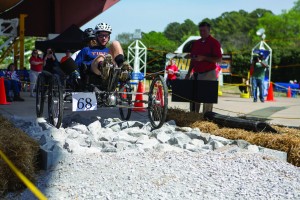Mechanical engineering seniors Jourdan Beaumont, Bradley Boyett, Taryn Greene, Robert Northup, Shawn Roades, Jacob Sparkman, Ryan Whitmore and Katie Zoladz placed fourth out of 46 college teams competing in the NASA Human Exploration Rover Challenge held at the U.S. Space & Rocket Center in Huntsville this spring. The competition focused on NASA’s plans to explore planets, moons, asteroids and comets, with teams instructed to design, construct and test technologies for mobility devices to perform in these different environments. Each  team’s vehicle had to be capable of overcoming large obstacles and able to fit inside a 5’x 5’x 5’ cube, in addition to being operated by two drivers – one male, one female. A competition rule change eliminated the use of pneumatic tires, which the Auburn team overcame by using solid rubber tires. The students spent much of the spring semester in the Wiggins Mechanical Engineering Hall machine shops building parts for their rover, which consists almost entirely of steel tubing with aluminum components and carbon fiber seats of their own creation. Commercial biking parts were used for the rover’s drivetrains such as pedals, chains, sprockets and brakes.
team’s vehicle had to be capable of overcoming large obstacles and able to fit inside a 5’x 5’x 5’ cube, in addition to being operated by two drivers – one male, one female. A competition rule change eliminated the use of pneumatic tires, which the Auburn team overcame by using solid rubber tires. The students spent much of the spring semester in the Wiggins Mechanical Engineering Hall machine shops building parts for their rover, which consists almost entirely of steel tubing with aluminum components and carbon fiber seats of their own creation. Commercial biking parts were used for the rover’s drivetrains such as pedals, chains, sprockets and brakes.